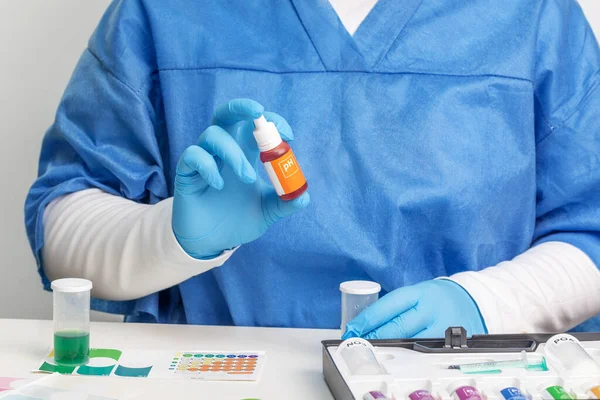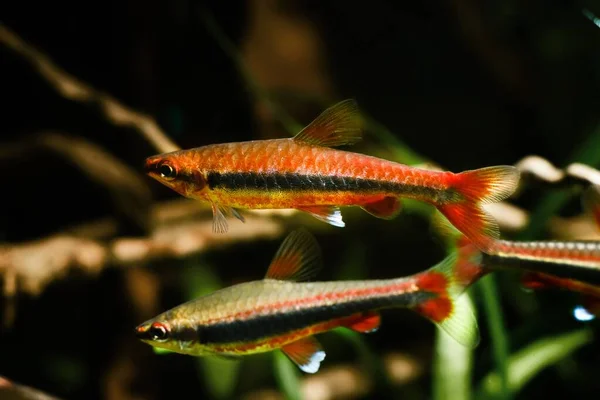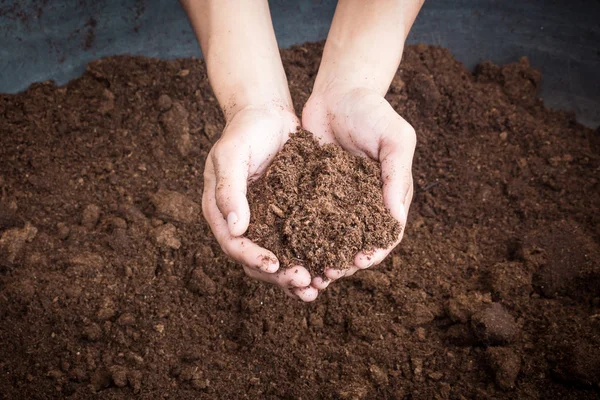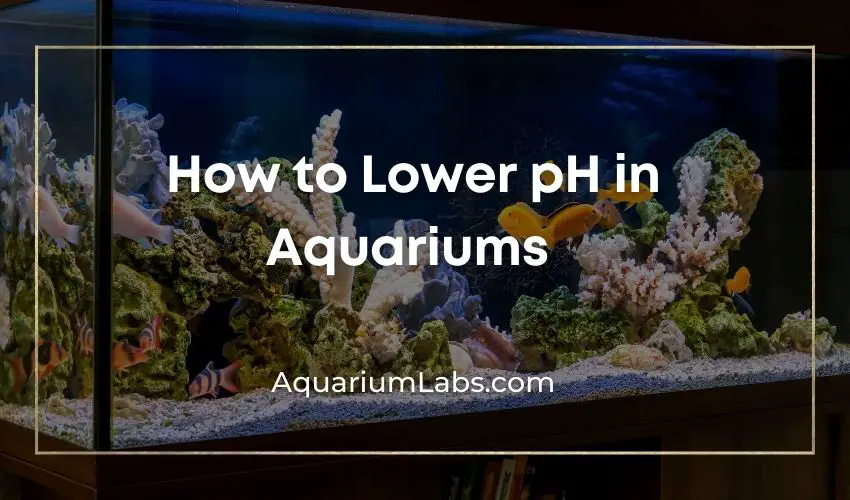Keeping track of the pH in a fish tank is important for maintaining a healthy environment for your fish.
But did you know that some fish like a high pH while others do not? If you like fish that prefer a lower pH, how do you go about providing it for them?
After all, tap water is almost always higher in pH value. And having used the term “pH” so much already…
So, how to lower pH in aquarium fish tanks? Let’s find out!
What Do pH Levels Mean?
Aquarium pH levels are one of those chemistry concepts that might feel a little intimidating at first. We all likely graduated high school chemistry. But how long has it been since we needed to answer a test question on what pH actually is? Fortunately, it is not that difficult to understand what the pH value of your water actually is!

The pH level is simply a measurement of the concentration of hydrogen ions (H+) relative to the hydroxide ions (OH-) in chemical solutions. If there are more hydrogen ions, then we say the solution is acidic. On the other hand, if the solution has more hydroxide ions, then we have a basic solution! Simple, right?
Well, there is one more wrinkle: pH levels are not a straightforward measurement. When you test pH, you are actually reading a logarithmic scale. This means that each step on the scale is a base 10 (10x) adjustment compared to the last step. pH 5 is 10 times more acidic than pH6. And pH 4 is 100x more acidic than pH 6. pH 9 is 10 times more basic than pH 8, and so on.
pH 7.0 is a neutral pH, meaning the concentration of hydrogen and hydroxide ions is balanced. Pure water (such as the kind coming from an RO filter) has a pH of 7.0 as well.
All marine aquariums will have basic (alkaline water) pH levels. But freshwater aquariums replicate environments that are much more diverse. They can have an acidic, neutral, or alkaline water ph, depending on what your fish and plants need.
Water Hardness
Before we talk about how to lower the pH, there is a second element to freshwater aquarium water chemistry to discuss: water hardness. Hardness is a description of the minerals dissolved in water; we say water is “hard” if it has a high concentration of minerals and “soft” if not.
Hardness is closely related to the pH in your aquarium and has a major effect on it. But they aren’t the same thing. If your water is loaded with buffering minerals, it will resist lowering pH.
The two measurements for water hardness are GH (General Hardness) and KH (Carbonate Hardness). GH measures the concentration of magnesium and calcium salts. These make up the limescale that forms not only in old pipes but also the white “chalk” along the water line when fish tank water evaporates.
Carbonate hardness is the measure of the carbonate concentration (CO3-). We measure this to determine how resistant our tank water is to swings in pH (buffering capacity). The higher the KH, the less it will shift suddenly when acids are introduced.
A high GH goes right along with a high KH in fish tanks because these elements and molecules are normally found bound together (CaCo3).
Tap Water pH and Hardness
Tap water chemistry in most countries is moderate to very alkaline. The water is also usually very hard, meaning there are a lot of dissolved minerals in the water as well. It would cost a lot of money to add equipment like a reverse osmosis filter to process wastewater into drinking water. Plus, these added minerals don’t affect human health in any way, so municipal water companies leave them.
When you test tap water using a pH test kit (see below), you will almost always get a high ph reading thanks to these minerals.
Do Aquarium Fish Need Soft Water?
The pH levels in fish tanks are not something that is set in stone and must be the same for every system. The aquarium pH levels you are aiming for depend on the kind of freshwater fish that you plan on keeping.
Different fish species have different water chemistry needs. This is easy to forget when you visit your local pet store and see fish from all over the world sharing a single fish tank.
But the majority of aquarium fish that pet stores carry are much more flexible in their water chemistry needs. These include Guppies, Zebra Danios, Tiger Barbs, and other hardy, captive-bred fish.

But some pets popular with fish tank owners are a little more demanding than you’d think. Tetras are a prime example. Even captive-bred tetras strongly prefer slightly acidic water conditions.
While they will survive with a higher pH, they are much more likely to get sick and will almost never breed. Other pets for a fish tank with a lower pH include Discus, Angelfish, Barbs, Rasboras, Betta fish, Gouramis, Corydoras, and Plecostomus.
Do Aquarium Plants Need a Lower pH?
Many people strongly believe that aquatic plants must be kept in soft water with a lower pH. Most plants do prefer conditions where the pH levels are at 7.0 or below.
The soil debris and mud that plants need is a constant source of organic acids that arise as matter decays along the bottom. So plants are well adapted to live in slightly acidic conditions.
But you don’t need to remove the minerals from the freshwater that you provide for the system. In fact, soft water can be a problem, especially if you add carbon dioxide (CO2) to the system. CO2 is also a weak acid and will lower the pH in a freshwater aquarium.
With no buffering minerals, the pH levels of your tank water will swing drastically. First, it will crash when carbon dioxide levels rise. And then, the pH will rise dangerously as plants remove CO2 via photosynthesis. These swings are dangerous for both plants and freshwater fish in your tank.
How to Lower pH in Aquarium Fish Tanks?
Now that we understand why pH levels sometimes need to be lowered, how do we go about this? Here are some of the most common ways to reduce pH levels in a fish tank!
Driftwood for the Freshwater Aquarium
One way to gradually reduce pH in a fish tank is to use natural methods like adding a piece of driftwood. A gradual reduction is important because fish adjust their biochemistry to match the water conditions they live in.
If you suddenly raise or lower the pH, it can fatally shock your pets. Remember, pH is a logarithmic scale, so a shift from pH 6.0 to 5.0 is a ten-fold increase in acidity.
Driftwood releases tannic acid over time as water soaks into the wood. How much is released depends mostly on the kind of natural driftwood you buy. Some, such as manzanita wood, are quite beautiful and easy to find.

But it has very low levels of tannic acids, so adding driftwood of this variety won’t affect the pH very much. If you don’t want the pH to raise or lower, then this is an advantage of using manzanita wood.
Instead, you can look for Mopani wood, Sumatran driftwood, and other types. If you aren’t sure of the variety, choose pieces that are on the softer side and have a dark hue. These tend to be loaded with tannic acids and will allow water to more easily penetrate them.
Driftwood pieces are also amazing tank decorations. So choose one that will make a great centerpiece or place for fish to hide and spawn within!
Indian Almond Leaves
Another popular way to bring the pH level down is to use Indian Almond leaves. These leaves reduce the pH by releasing tannic acids over time, just like aquarium driftwood does.
Since Indian Almond leaves are rich in these molecules, you should be careful how many you add. Otherwise, the tank’s ph levels can crash rather quickly, harming even fish that prefer a lower pH.
What’s more, the leaves impart a very natural look. Many bodies of water have leaves, twigs, and other debris along the bottom. When artfully arranged in a fish tank, they add realism to any aquascape.
Small fish fry and shrimp use them as natural hiding spots and places to feed. And the plant acids and other molecules can promote better color and even spawning behavior in fish.
This video does an excellent job of breaking down the positives and negatives of using almond leaves in a fish tank!
Using Peat Moss to Treat Water
Peat moss is yet another way to introduce plant tannic acids into your aquarium water. Peat moss works by doing the exact same thing as almond leaves or driftwood. Water penetrates it and slow-releases the agents into your aquarium water.
But you should be careful with how much you add because peat moss can hold a lot of tannins. It is not as exact as adding a precise amount of bottled chemicals (see below). And it may not take much to bring the pH level down more than you wanted.
So be careful not to add too much peat moss all at once. Instead, I recommend starting off with adding peat moss to a small filter bag. The peat moss should be a wet, compressed lump about the size of a golf ball for aquariums 10 gallons or larger.

After you add peat moss to a power or canister filter chamber, monitor the pH over the course of 2-3 days. And then add more if needed to get the pH in your aquarium where you want it!
By the way, all of these methods will also stain your fish tank water a dark tea color. This depends on how much peat moss you add and the total water volume.
Some people really like the look of peat moss-treated water, however. It is very natural and looks amazing with twisting driftwood, colorful fish lighting up the murk, and almond leaves along the bottom. Blackwater aquariums and other biotopes with tannin-rich water are very popular these days.
Chemical Additives that Lower pH
One more way you can lower the pH of your fish tank is to use chemical additives. These have the advantage of being more precise at achieving a target pH level than adding peat moss, driftwood, or almond leaves.
But they aren’t nearly as decorative as driftwood and other additions. These chemical additives are slowly removed as you perform proper maintenance like aquarium water changes. So each time you add treated tap water, you will need to add some of these acids as well.
One benefit to using agents like API pH Down is that they don’t turn the water brown. If you prefer clear water, these are better than peat or other organic methods. However, there are brands like Brightwell Aquatics Blackwater that include the darker organic molecules without needing to add driftwood or peat. This way, you get all of the convenience of a bottled product with the benefits of natural blackwater additives.
Monitoring pH Levels in a Fish Tank
Just because we’ve added acids to the tank and lowered the pH does not mean our job is over. We still need to keep track of the changes we’ve made after we lower the pH.
Aquarium Water Test Kits
One way of tracking aquarium and tap water chemistry changes is to use a water test kit. These kits use liquid reagents to precisely measure how acidic or alkaline the pH in your aquarium is. While they can take a few minutes to get results, they are very accurate.

The most popular by far is the API Master Freshwater Test Kit. It includes both regular pH and high pH ranges. You can also measure the concentration of the toxic elements ammonia, nitrite, and nitrate.
Dip Test Strips
Dip test strips are a faster way to get a reading on the water conditions of your aquarium once you lower the pH. The upside is that they are cheap and give you a result quickly without much preparation.
However, they are much less accurate than using liquid reagents. If you want a result that is a ballpark estimate and ensures you haven’t crashed the pH, then dip test strips are good to have on hand. But every aquarist should have a liquid test kit on hand for more refined measurements.

Using Reverse Osmosis Water
Strictly speaking, reverse osmosis water does not lower the pH. RO water is just water free of dissolved minerals. Water is forced through a semi-permeable membrane that screens out almost everything except for water molecules. The result is ultrapure water with a pH close to perfectly neutral (7.0).

Some aquarists use reverse osmosis water when doing water changes. This is one of the best ways to maintain soft water conditions and a low pH. Usually, you only do this for specific setups.
Blackwater fish and certain rare freshwater shrimp need these conditions and would die if normal tap water were used during water changes.
You can also use reverse osmosis water for tetra and discus fish breeding, but it can be overkill for all except wild fish.
Some people already have an RO filter set up in their home for drinking and bathing needs. So there is no reason why you can’t use this water to fill an aquarium with a lower pH as well!
Wrapping Up
Lowering the pH of a fish tank is not all that difficult to do. You simply have to add more acidic agents (H+ ions) until you overwhelm the buffering capacity (OH-) of the solution. But keeping the talk acidic can be fairly challenging.

Strategies like peat moss, driftwood, and almond leaves all help to lower pH levels and then keep them there. If you have live aquarium plants, then adding carbon dioxide will further push the chemistry towards acidity.
And don’t forget how valuable using pure water can be! If you have an easy source of RO water, you can not only lower the pH but keep it there. Not having to fight the dissolved minerals that tap water contains will save you a lot of time and effort.
Related Reading:
- How to Raise KH in Freshwater Fish Tanks
- How to Make Tap Water Safe Without Conditioner
- How to Reduce Water Hardness in Aquariums

